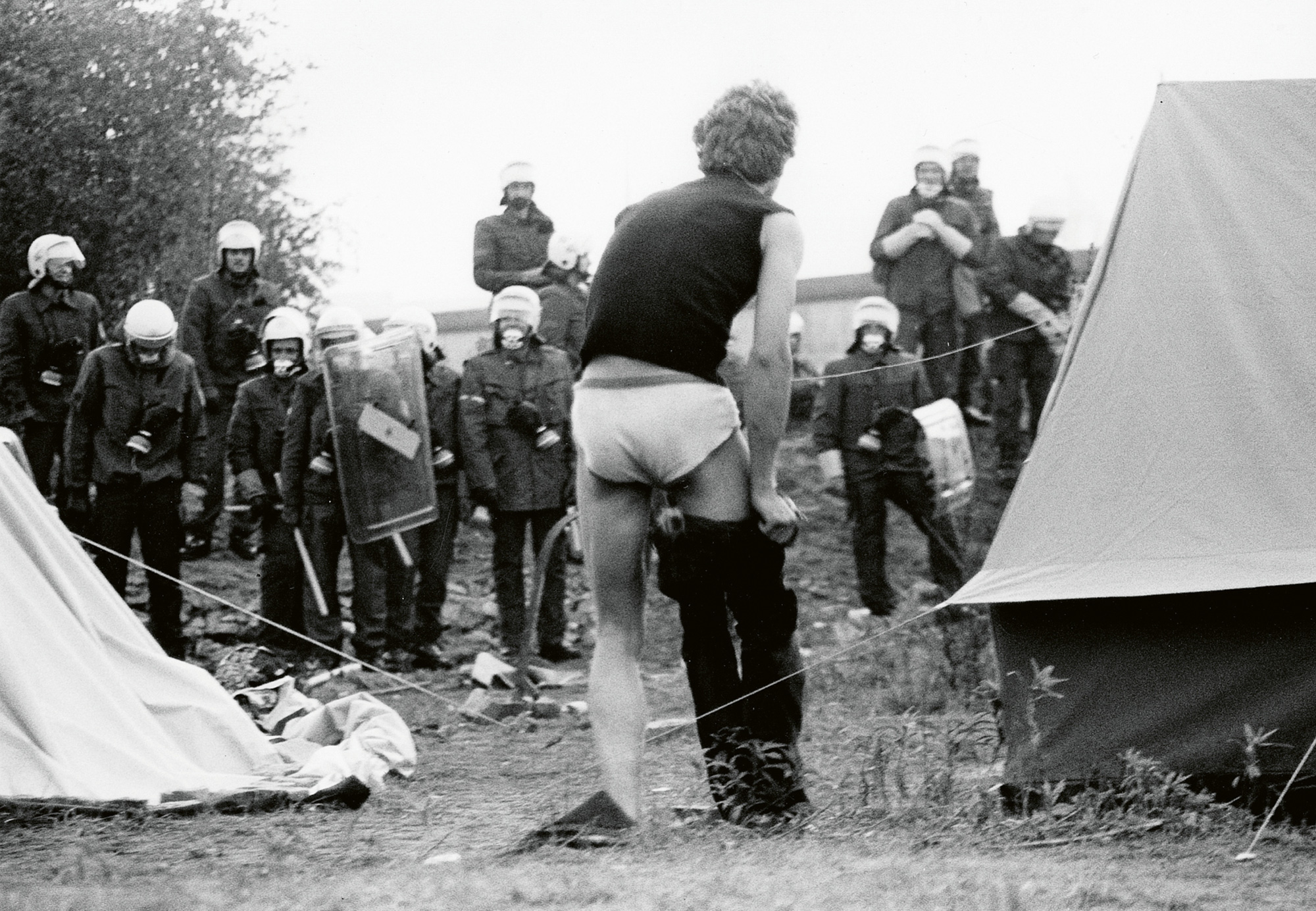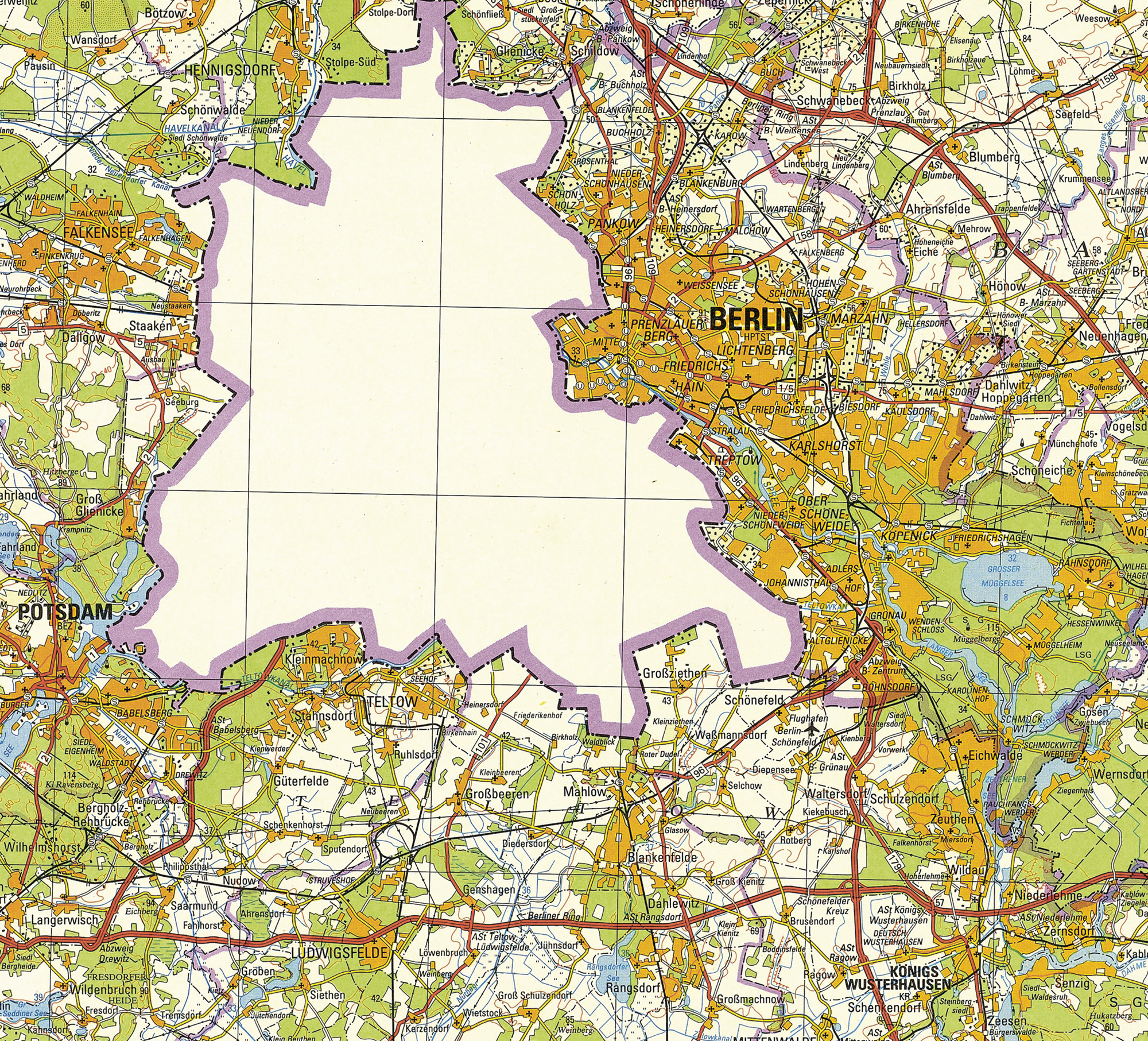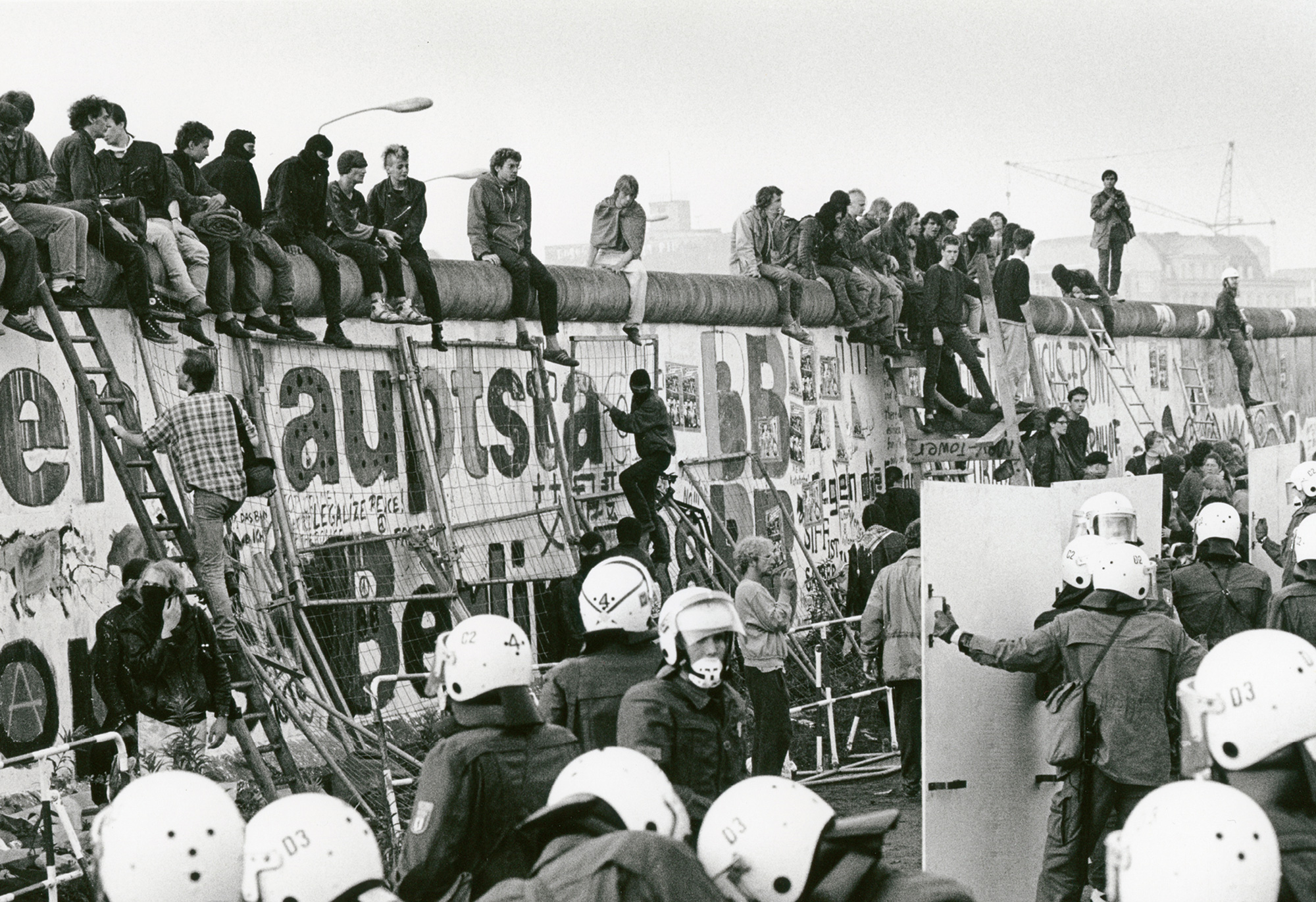Between the Wall
A territorial scrap in Cold War Berlin
Jesse Coburn

One balmy summer morning in 1988, a young officer in the East German border patrol stood near Potsdamer Platz, the empty center of divided Berlin, and stared at the Berlin Wall. From the other side, he could hear the sounds of hundreds of people rousing themselves from sleep. For five weeks, a disparate coalition of West German activists had occupied an overgrown plot of land called the Lenné-Dreieck (Lenné Triangle) in protest of West Berlin’s plans to develop the site. Although it lay west of the wall, the triangle technically belonged to East Germany—a minor discrepancy between physical and political definitions of the border that had allowed the occupation to proceed unchecked for all of June. On that morning, however, a land trade between the two sides had finally taken effect, and the Lenné Triangle officially passed into the jurisdiction of West Berlin. Shortly before 5 am, the officer (who asked to be called Frank in this article) heard a message on his two-way radio: “The police are coming.” Border guards posted on top of the Brandenburg Gate had watched an endless file of West Berlin police cars and armored trucks stream down the Strasse des 17. Juni, heading for the occupation. There had been rumors, and the border guards’ superiors had provided them with contingency plans in the days prior, but Frank wasn’t sure how the confrontation would play out. “No one knew what was really going to happen,” he said in an interview in 2013.
Nine hundred West Berlin police officers amassed on the edge of the Lenné Triangle, with journalists and onlookers gathered behind them. A police spokesman barked out repeated orders over a megaphone for the protesters to clear the site. TV news cameras rolled. Some of the occupiers left, but most stayed, so the police descended on the camp. In the scrum that followed, a group of protesters scrambled up makeshift ladders to the top of the wall. It was a tense moment; no one was certain how the East Germans would respond. To almost everyone’s surprise, Frank and the other border guards helped them down into the “Death Strip”—a heavily militarized swath of empty space that ran behind the western face of the wall—and loaded them into trucks, which then set off toward East Berlin. More protesters followed—almost two hundred of them in the span of twenty minutes. It was the single largest exodus from West to East in the history of the Cold War. Frank watched the trucks carry the incidental refugees across the empty expanse of the Death Strip toward the eastern half of the divided city. “It’s over,” he thought, and went home to take a shower.
• • •
For all the drama of its recent past, the Lenné Triangle had been a mostly unremarkable place for the larger part of its history. In the 250 years prior to the occupation, the ten-acre wedge of land between Potsdamer Platz and the Tiergarten park had served in a variety of capacities, playing host to a parade ground for the Prussian military, a school garden, and a popular middle-class dance hall and restaurant.

The troubles surrounding the site could be traced back to 1920, when the Groß-Berlin-Gesetz (Greater Berlin Act) allotted the land to the newly established Tiergarten district as part of an expansive redistricting of the city. In a minor amendment to these borders eighteen years later, the Lenné Triangle, by then a bustling, upscale neighborhood, was reassigned to the Mitte district, as if in anticipation of the land’s coming existential ambiguity.
These mundane administrative procedures proved more consequential than anyone could have expected. After World War II, the Allied Powers divided up Berlin along its district borders, and the Lenné Triangle fell into the Soviet Occupation Zone, adjacent to the British sector. But it stuck out awkwardly, which is probably why the East Germans built the wall just east of the parcel sixteen years later, in a literal demonstration of cutting corners. The Lenné Triangle wasn’t the only plot of land to be cut off from its rightful owner in the division of the city. West Berlin alone technically included almost a dozen small parcels that lay on the other side of the wall in East Germany (the GDR). If West Berlin was an island, as a common metaphor of the era suggested, then these exclaves formed its archipelago—a chain of micro-colonies splayed out across the Brandenburg region in total geographic isolation from one another.
A decade after the wall went up, the Four Power Agreement eased relations between East and West Berlin, and the two halves of the city set to work correcting the irregularities in their border. In the 1970s and 1980s, West Berlin and the GDR conducted a series of negotiations in which they traded (or just as often, West Berlin bought) more than five hundred acres of misplaced land in a continuous effort to refine the border, to resolve its numerous small contradictions.
West Berlin went after the Lenné Triangle in the 1980s. By then, the plot had become a no-man’s-land in the most literal sense. Allied bombing had all but leveled the prewar buildings on the site, and East Germany had done little more to the land before building the wall than clear away the rubble. West Berlin’s interest in the Lenné Triangle stemmed from its longstanding plans to encircle the walled-in city with a ring of highways, one section of which was to run directly across the site. The two sides agreed to terms in March 1988, and the triangle was officially to change hands on 1 July.
But in nearly thirty years of relative isolation, nature had renewed its claim to the land. By 1988, the Lenné Triangle was teeming with life. Over 160 plant species had been counted on it. Rabbits, birds, and other animals had nested there. In May, to protest the highway and to protect this improbable urban wild, a small group of environmental activists moved in.
• • •
The implications of the Lenné Triangle’s political status weren’t lost on the early occupiers. The East Berlin border patrol did clear the first small wave of protesters from the site, but it didn’t intervene when they returned at the end of May, and the Allied Powers, who still retained political and military authority in the city, showed no intentions to do so either. The West Berlin government could do little more than watch. “You don’t let a chance like that go by,” Stephan Noë said in an interview in 2013. Noë, then a representative in one of the city’s district assemblies, was one of the first protesters at the triangle.
With an imminent raid out of the question, the occupiers made themselves comfortable. Tents gave way to huts, built with materials stolen from nearby construction sites. Goats and chickens roamed on a small farm. Much to the protesters’ surprise, signs of support streamed in from throughout West Berlin. “Old ladies were bringing us cakes,” Noë said. The camp received enough in monetary donations to buy the equipment for a pirate radio signal.
Word spread, and the occupation swelled. Soon, the environmentalists were camping next to punks and autonomists, as well as students and office workers. To stem the influx of newcomers, the police put up a chain-link fence along the western and northern sides of the site (rechristened Norbert Kubat Triangle, after a political protester who had killed himself in jail a year prior). But this new wall had little effect: the flow of supplies and new protesters continued uninterrupted along the Unterbaugebiet, a narrow strip of GDR territory that ran along the entirety of West Berlin’s side of the wall and was equally off-limits to its authorities. (West Berlin’s steadfast refusal to officially acknowledge even the existence of the border between the two halves of the city was chief among the reasons that it did not attempt to cordon off the Unterbaugebiet, although the logistical hurdles this would have entailed were similarly discouraging.)
Faced with the futility of their position, the West Berlin police resorted to increasingly desperate tactics. They hosed the camp down with water cannons by day, and blasted music into it at night. (Their playlist included, strangely, Queen’s “We Are the Champions.”) Some of the more radical factions of the occupation fought back with rocks and Molotov cocktails. The police answered with tear gas. Occasionally, East Berlin border guards could be seen poking their heads over the wall to follow the skirmishes. “They watched as if it were a sporting event,” Frank said. “The whole story is absurd.” Toward the end of June, with the date of the land transfer looming on the horizon, the protest took on an apocalyptic cheer. “There were people there who had nothing to do with the occupation,” Noë said. “They came from West Germany to spend ten days there on an adventure vacation and then went back home.” Some occupiers offered tours of the camp in exchange for monetary donations. “People wanted to see what was going on there,” Frank said. “They didn’t go up on the viewing platform [on Potsdamer Platz] to look out at East Berlin anymore, they were looking at what was happening on this crazy piece of East German territory.” Whatever utopian potential the Lenné Triangle may have initially possessed had given way to pure spectacle. Many of the original environmentalists had left the site by then; the occupation they’d initiated had damaged the ecosystem they’d come to protect.
• • •
Stephan Noë didn’t jump over the wall on 1 July. His unofficial role as occupation spokesman had granted him de facto immunity, so he stuck around to talk to journalists and watch the police try to make sense of what had just happened. According to a count taken from a British military helicopter, 182 people made the illegal border crossing into the GDR that day. Although surprising, the jump was far from spontaneous. In a press conference days earlier, Noë had announced the intention of many of the occupiers to go over the wall in the event of a police raid, and they had even given East Berlin advanced warning through various channels. After weeks of violent clashes with the police, the occupiers left the Lenné Triangle peacefully. From the viewing platform on Potsdamer Platz, tourists could see the border patrol trucks ushering the fugitives into East Berlin. The guards brought the group to a government office close to the wall, where GDR officials conducted a round of light interrogations over a warm breakfast of sausage, cheese, and bread rolls. They asked the Westerners why they had decided to visit the German Democratic Republic, and if they were interested in staying in the country permanently. The protesters politely declined.


After breakfast, the occupiers were escorted to border checkpoints of their choosing in groups of six. Most opted for the subway station at Friedrichstraße, the only border crossing in the divided city’s public transit system. There, the GDR officials saw them onto platforms for westbound trains, where they supplied them with subway tickets and asked them to kindly pass through a designated checkpoint upon their next visit to East Germany. After the most brazen and dramatic border crossing imaginable, most occupiers of the Lenné Triangle took the subway home. Back in West Berlin, policed prowled the S- and U-Bahn stations in search of the returning interlopers, but were only able to identify thirteen of them.
It’s not entirely clear why East Berlin received the occupiers peacefully, or why it tolerated the occupation in the first place. One plausible theory depicts the GDR’s choice as the lesser of two evils, as suppressing the protest would have amounted to tacit cooperation with West Berlin.
Neither side was particularly pleased with the spectacle—especially not the West. After clearing the remaining protesters from the triangle, West Berlin destroyed the camp with neurotic efficiency, tearing down the hundreds of huts, uprooting every plant on site, and digging a hole many meters deep. The excavation was necessary, they explained, as the site was littered with active munitions from World War II. (The occupiers had found a old, rusted gun weeks earlier.) There were a lot of reasons for West Berlin to want to clean up its image that summer. The city had been designated Europe’s “Cultural Capital” of 1988, and the International Monetary Fund had a major conference planned there in the fall.
West Berlin’s search for old bombs wasn’t in vain: a small grenade turned up on 6 July. And in the months and years that followed, as construction crews dug even deeper into the soil under the Lenné Triangle, they unearthed large bombs left over from Allied air raids. None of these munitions were close enough to the surface to have posed any real threat to the occupiers of the triangle. But the real point of that first excavation in 1988 seemed clear enough: nothing to see here. Eventually, the tourists on the viewing platform returned their gaze to East Berlin. As Frank remembers it, media attention fizzled just as fast. “A few days later, it was like it hadn’t happened,” he said. Both sides seemed happy to put the whole thing behind them. “For West Berlin, it was inconceivable that so many Westerners had fled to the East, and East Berlin didn’t want to have any imitators, of course,” Frank said. “If hundreds of people had ever met up somewhere and said, ‘Hey, let’s shove over the border,’ nothing could have been done about it.”
There weren’t any large groups of imitators, at least not from the western side of the wall, but the occupation of the Lenné Triangle makes it seem like there could have been. Blind spots like the triangle were part and parcel of a border cast in deep ambivalence. Neither side could even begin to agree on what the wall officially was, or where, or what it meant. The competing definitions of the boundary pulled at its seams, revealing ellipses and omissions that were primed for misuse—if only for a moment. “In 1988, you could say that the space in which we moved was confined by the wall,” Noë said. “But I’d never felt more free. Today the wall is gone and I feel even more penned in than before.”
In the early 2000s, a German business magnate invested 900 million Deutschmarks in a luxury development on the Lenné Triangle and gave the new district his name: Beisheim Center. There are restaurants and offices, a couple of hotels and a small park. Frank doesn’t spend very much time around Potsdamer Platz anymore, except for the occasional movie with his children. “It’s hard to find where the Lenné Triangle even was,” he said. Stephan Noë is more certain of its whereabouts: “The Lenné Triangle is gone. It has completely disappeared.”
An earlier version of this article appeared in Stadtaspekte, no. 2 (July 2013).
Jesse Coburn is a New York–based journalist and editor-at-large of ARCH+. He is the author of City Notes: San Francisco (Terry Warner Press, 2011).
Spotted an error? Email us at corrections at cabinetmagazine dot org.
If you’ve enjoyed the free articles that we offer on our site, please consider subscribing to our nonprofit magazine. You get twelve online issues and unlimited access to all our archives.